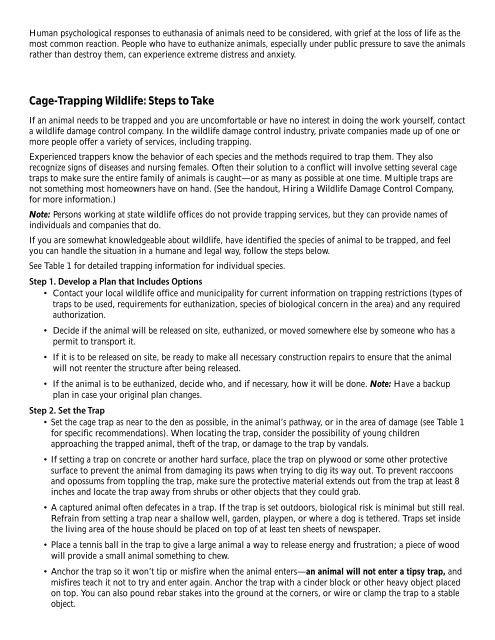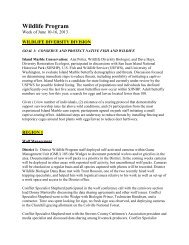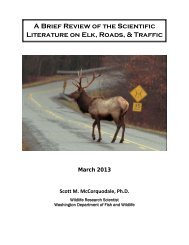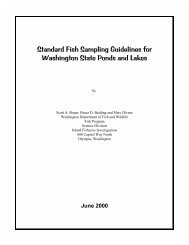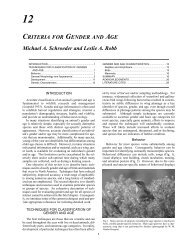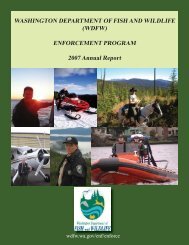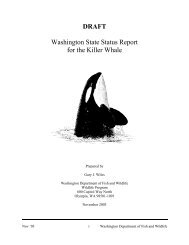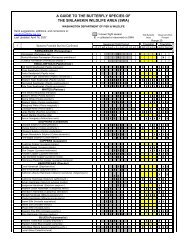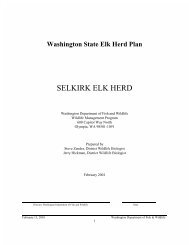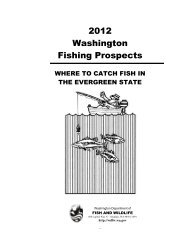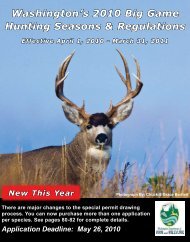Trapping Wildlife - Washington Department of Fish & Wildlife
Trapping Wildlife - Washington Department of Fish & Wildlife
Trapping Wildlife - Washington Department of Fish & Wildlife
Create successful ePaper yourself
Turn your PDF publications into a flip-book with our unique Google optimized e-Paper software.
Human psychological responses to euthanasia <strong>of</strong> animals need to be considered, with grief at the loss <strong>of</strong> life as the<br />
most common reaction. People who have to euthanize animals, especially under public pressure to save the animals<br />
rather than destroy them, can experience extreme distress and anxiety.<br />
Cage-<strong>Trapping</strong> <strong>Wildlife</strong>: Steps to Take<br />
If an animal needs to be trapped and you are uncomfortable or have no interest in doing the work yourself, contact<br />
a wildlife damage control company. In the wildlife damage control industry, private companies made up <strong>of</strong> one or<br />
more people <strong>of</strong>fer a variety <strong>of</strong> services, including trapping.<br />
Experienced trappers know the behavior <strong>of</strong> each species and the methods required to trap them. They also<br />
recognize signs <strong>of</strong> diseases and nursing females. Often their solution to a conflict will involve setting several cage<br />
traps to make sure the entire family <strong>of</strong> animals is caught—or as many as possible at one time. Multiple traps are<br />
not something most homeowners have on hand. (See the handout, Hiring a <strong>Wildlife</strong> Damage Control Company,<br />
for more information.)<br />
Note: Persons working at state wildlife <strong>of</strong>fices do not provide trapping services, but they can provide names <strong>of</strong><br />
individuals and companies that do.<br />
If you are somewhat knowledgeable about wildlife, have identified the species <strong>of</strong> animal to be trapped, and feel<br />
you can handle the situation in a humane and legal way, follow the steps below.<br />
See Table 1 for detailed trapping information for individual species.<br />
Step 1. Develop a Plan that Includes Options<br />
• Contact your local wildlife <strong>of</strong>fice and municipality for current information on trapping restrictions (types <strong>of</strong><br />
traps to be used, requirements for euthanization, species <strong>of</strong> biological concern in the area) and any required<br />
authorization.<br />
• Decide if the animal will be released on site, euthanized, or moved somewhere else by someone who has a<br />
permit to transport it.<br />
• If it is to be released on site, be ready to make all necessary construction repairs to ensure that the animal<br />
will not reenter the structure after being released.<br />
• If the animal is to be euthanized, decide who, and if necessary, how it will be done. Note: Have a backup<br />
plan in case your original plan changes.<br />
Step 2. Set the Trap<br />
• Set the cage trap as near to the den as possible, in the animal’s pathway, or in the area <strong>of</strong> damage (see Table 1<br />
for specific recommendations). When locating the trap, consider the possibility <strong>of</strong> young children<br />
approaching the trapped animal, theft <strong>of</strong> the trap, or damage to the trap by vandals.<br />
• If setting a trap on concrete or another hard surface, place the trap on plywood or some other protective<br />
surface to prevent the animal from damaging its paws when trying to dig its way out. To prevent raccoons<br />
and opossums from toppling the trap, make sure the protective material extends out from the trap at least 8<br />
inches and locate the trap away from shrubs or other objects that they could grab.<br />
• A captured animal <strong>of</strong>ten defecates in a trap. If the trap is set outdoors, biological risk is minimal but still real.<br />
Refrain from setting a trap near a shallow well, garden, playpen, or where a dog is tethered. Traps set inside<br />
the living area <strong>of</strong> the house should be placed on top <strong>of</strong> at least ten sheets <strong>of</strong> newspaper.<br />
• Place a tennis ball in the trap to give a large animal a way to release energy and frustration; a piece <strong>of</strong> wood<br />
will provide a small animal something to chew.<br />
• Anchor the trap so it won’t tip or misfire when the animal enters—an animal will not enter a tipsy trap, and<br />
misfires teach it not to try and enter again. Anchor the trap with a cinder block or other heavy object placed<br />
on top. You can also pound rebar stakes into the ground at the corners, or wire or clamp the trap to a stable<br />
object.


